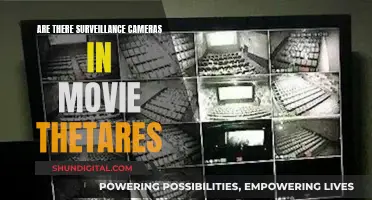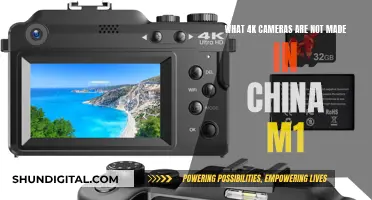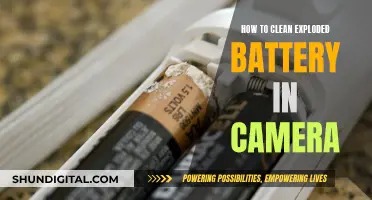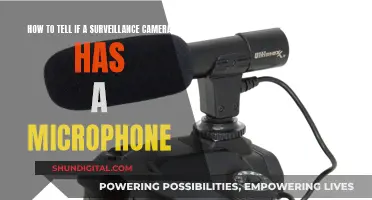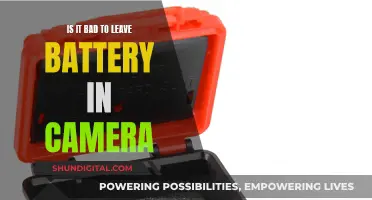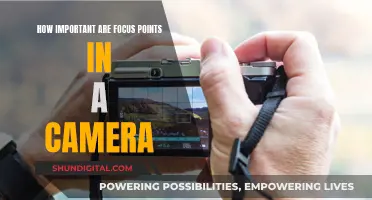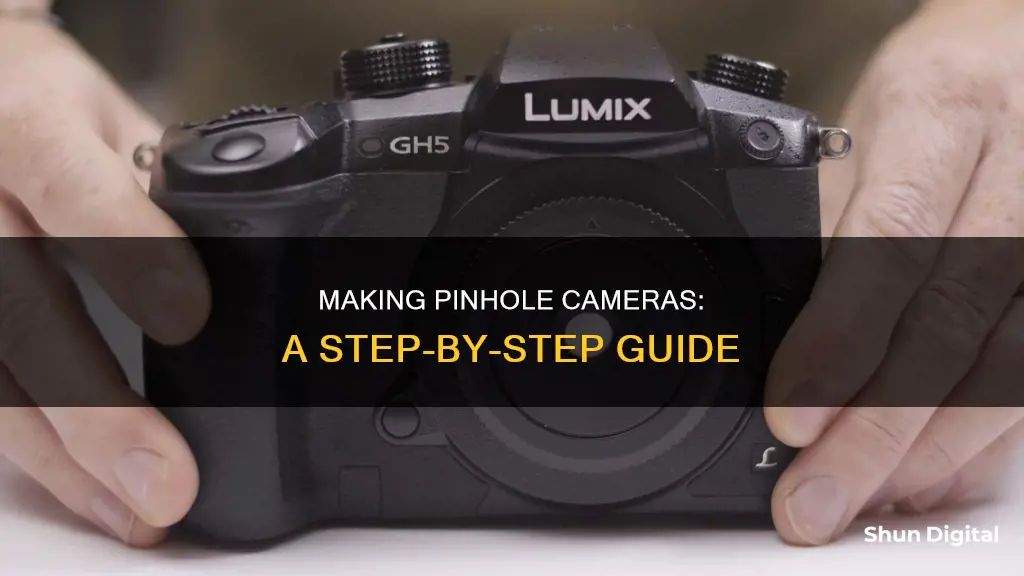
Pinhole cameras are one of the earliest predecessors of modern-day cameras. They are the simplest type of camera, consisting of a light-proof box, some sort of film, and a pinhole. The pinhole is an extremely small hole that light enters through, creating an upside-down image on the opposite side. This allows for basic photography without the need for a lens. Pinhole cameras can be handmade by photographers for a particular purpose, often using simple materials available at home.
| Characteristics | Values |
|---|---|
| What is a pinhole camera? | A simple camera without a lens that uses a tiny opening to focus light rays and obtain an image. |
| How does it work? | Light from a scene passes through a tiny aperture and projects an inverted image on the opposite side. |
| What is the image like? | Smaller than the actual object, inverted on the x-axis and y-axis, and can be projected onto a screen for real-time viewing. |
| What is it used for? | Capturing the movement of the sun (solargraphy), artistic purposes, educational purposes, and surveillance. |
| How is it made? | With a light-proof box, some sort of film, and a pinhole. The pinhole can be made with a thin piece of metal and the box can be painted black to avoid reflections. |
What You'll Learn

Choosing a suitable box
The first step to making a pinhole camera is to choose a suitable box. The box should be light-proof, with a small hole in one side. You can use a variety of containers such as a cylindrical or rectangular can or box. Pick a container that is about the size of a normal camera and is clean, such as an old paint can, oatmeal container, shoe box, or coffee can. Make sure your container has a tight-fitting lid, as this will be important for keeping out unwanted light.
Once you have chosen your container, you will need to paint it black inside and out, or cover it completely with aluminium foil. This step is crucial as it will prevent any light reflection from occurring on the inside of the box. Be sure to paint the entire lid of your container and allow the paint to dry completely before moving on to the next step.
The next step is to determine the size of your pinhole. The distance between the film and the pinhole will affect the outcome of your photos. For a container with a 3 to 6-inch distance between each end, use a No. 10 sewing needle pushed about halfway up the needle shaft to make your pinhole. You can either poke a hole directly through the bottom of your container or cut a larger hole and poke a pin through a separate piece of paper or thin metal. This second method allows for a more perfect circle and gives you the option to start over if you make a mistake.
After you have made your pinhole, check that it is circular by looking through the back of the camera where the film will be and peering through the hole. Ensure that you can see whatever is on the other side of the pinhole clearly.
Unlocking Beauty Mode on Your LG Camera
You may want to see also

Light-proofing the box
Choose the Right Box
Select a box that is sturdy and made of opaque material. A shoe box, tea box, or a small wooden crate can work well. Avoid using transparent or translucent containers as they will not effectively block out light.
Paint the Box
Consider painting the entire box black, both inside and out. Black paint will help absorb any stray light that manages to enter the box, reducing the risk of light leaks that can affect your images.
Light-proof the Interior
Line the interior of the box with black paper or fabric. This extra layer of covering will ensure that all surfaces inside the box are light-absorbent and will not reflect light onto the film or viewing screen.
Seal Openings
If your box has any openings or gaps, seal them securely. You can use black duct tape or aluminium foil to cover these areas, ensuring no light can enter through these points. Check that the box remains completely dark even after closing the lid or any doors.
Create a Removable Liner
Consider creating a removable liner for your box. This liner should be made of black cardboard or thick paper, with no back, and should fit snugly inside the box. The liner will hold the film or photographic paper and can be easily inserted and removed in complete darkness.
The Pinhole
When creating the pinhole, start with a small hole, as you can always make it bigger if needed. The pinhole can be made in the centre of the removable liner or on the bottom of the box, depending on your design. Use a sharp needle or a small-diameter bit to create a clean, precise hole in a thin piece of aluminium, brass, or tin foil. Tape this piece securely over the hole you cut in the box, ensuring no gaps are present.
Remember, the key to successful light-proofing is to create a completely dark environment inside the box, allowing only the pinhole as a source of light to create the inverted image on the opposite side.
Candid Camera Mode: Capturing Unscripted Moments
You may want to see also

Creating an aperture
To create the aperture, you'll need to cut a small hole in the side of your light-proof box. This can be done with a craft knife or scissors. The hole should be around 1 to 2 centimetres in size. This will allow light to enter the camera and project an image onto the opposite side.
The optimal size of the aperture is dependent on the distance between it and the projected image. As a general rule, the smaller the hole, the sharper the image will be, but the dimmer it will appear. Up to a certain point, a smaller pinhole will result in a sharper image because the projected circle of confusion at the image plane is similar in size to the pinhole.
However, if the hole is too small, it can cause significant diffraction effects, leading to a less clear image. This is due to the wave properties of light. Additionally, if the diameter of the hole is close to the thickness of the material it is punched into, vignetting may occur. This is because the sides of the hole obstruct light entering at angles other than 90 degrees.
For the best results, the pinhole should be perfectly round, as irregularities can cause higher-order diffraction effects. A thin piece of material, such as aluminium foil, is ideal for creating the pinhole. You can use a sewing needle or a small-diameter bit to create the hole. Once you've created the pinhole, tape it to the inside of your light-tight box, behind the hole you've cut.
The Intricate Art of Crafting Camera Lenses
You may want to see also

Making a shutter
Step 1: Choose Your Material
You can use various materials for the shutter, such as cardboard, cardstock, wood, or even plastic. Cardstock that is thick and opaque is ideal because it doesn't allow light to pass through and is sturdy enough not to fold. However, any material that is light-proof and easy to work with will do.
Step 2: Cut Out the Shutter
The size of the shutter will depend on the size of the pinhole and the camera body. For a typical pinhole camera, a square shutter measuring about 2 inches by 2 inches should be sufficient. Cut out a square from your chosen material, ensuring it is large enough to completely cover the pinhole.
Step 3: Attach the Shutter
Use strong tape, such as electrical or duct tape, to attach the shutter to the body of the camera. Tape one edge of the shutter above the pinhole, creating a hinge that allows you to open and close it easily. Make sure the tape is sturdy enough to hold the shutter in place but not so strong that it becomes difficult to adjust.
Step 4: Secure the Shutter
To keep the shutter closed when not taking a picture, use a less sticky tape, such as electrical tape, to secure the opposite end of the shutter underneath the pinhole. This will prevent light from entering the camera unintentionally. Alternatively, you can use a small piece of cardboard or wood as a stopper to keep the shutter closed.
Step 5: Test the Shutter
Once the shutter is in place, test it by opening and closing it a few times. Ensure that it moves smoothly and covers the pinhole completely when closed. Make any necessary adjustments to the hinge or stopper to achieve a light-tight seal.
With these steps, you can create a functional shutter for your pinhole camera, allowing you to control the exposure of your images. Remember to be creative and adapt these instructions to fit the specific design of your camera.
Kami Wire-Free Camera: How Long Does the Battery Last?
You may want to see also

Adding a viewfinder
Materials
You will need:
- Cardboard
- Strong tape or hot glue
- A piece of metal, such as a washer
- A lanyard (optional)
Instructions
First, cut a piece of cardboard to the shape of your film. This will be your front viewfinder. Secure it with strong tape or hot glue directly above the pinhole.
Next, create a rear viewfinder by cutting a perfect circle out of cardboard. This will act as a peephole, so you can see what your photo will look like. Attach this to the top of your camera with tape or glue. If you're using a metal washer, attach this to the rear viewfinder instead.
You can also make a simple lanyard for your viewfinder by punching a hole in the side and threading a piece of string or cord through it. This will allow you to wear the viewfinder around your neck, keeping it secure and easily accessible.
Tips
When taking photos of subjects closer than five feet away, position your subject lower in the viewfinder to account for the difference between your perception and the angle of the pinhole.
If you're new to pinhole photography, you may find it helpful to train yourself to visualise the frame without a viewfinder. This can be done by paying close attention to the results of your photos and making adjustments as needed.
The Magic Behind Polaroid Cameras Charging
You may want to see also
Frequently asked questions
A pinhole camera is a simple camera without a lens. It uses a tiny aperture (the pinhole) to allow light to pass through and project an image on the opposite side of the box.
You can make a pinhole camera with simple materials found at home. You will need a small box, black paint, thick black chart paper, duct tape, light adhesive, cardboard, and a tool to cut a small hole (such as a craft knife or scissors).
First, take a small box and paint it black to make it light-proof. Then, determine the distance between the film and the light source, and make a circular pinhole on the bottom of the box. Create a shutter by cutting a piece of thick black chart paper and use duct tape to hold it in place. Use light adhesive to control the shutter flap and the light entering the box. Finally, make a viewfinder from cardboard.
The size of the pinhole is critical. Up to a certain point, a smaller hole will result in a sharper image, but the image will be dimmer. The optimal size of the aperture is 1/100 or less of the distance between it and the projected image. The interior of the camera should be black to avoid any reflection of light. The distance between the film and the pinhole can also be adjusted to change the angle of view and exposure time.


